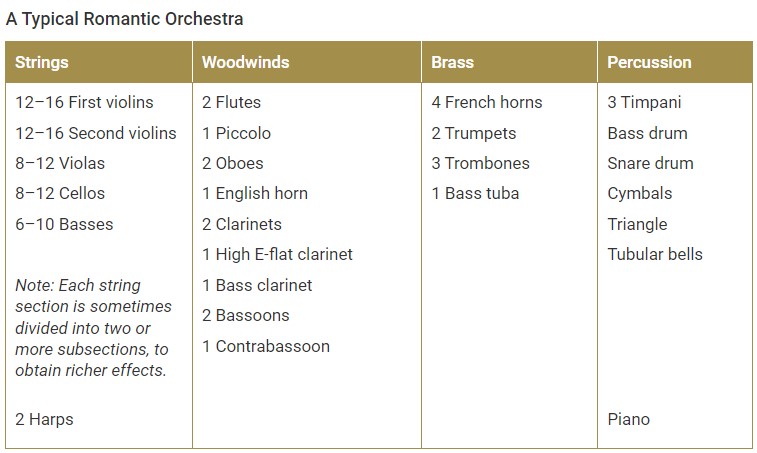4.16 Music After Beethoven: Romanticism
- ==Terms== for historical periods of arts are used ==after the fact==, generally
- Baroque was adopted from art historians in the 20th century
- Romantic, was uniquely used by the Romantics themselves
- Earliest Romantic composers were in the ==1820s==
- Music after Beethoven
- Music was seen as a major art now
- ==Music was taken seriously==
- Some think that lit. and music developments line up
Romanticism
- Great age of ==English literature== around ==1800-1829==
- Wordsworth, Coleridge, Shelley, Keats, Byron
- There was also ==German Romantic lit.== around the same time
- Less commonly known
- Tieck, Novalis, Kleist, Hölderlin, and E. T. A. Hoffmann
- “Romantic” meaning love started with this ==literary movement==
- ==Glorification of love== was a theme in literature and music
The Cult of Individual Feeling
- “Striving for a better, higher, ideal state of being was at the heart of the Romantic movement”
- ==Emotional expression== was the highest goal
- Bohemians
- ==Jean-Jacques Rosseau== was an Enlightenment philosopher who was “hailed as the philosophical father of the French Revolution”
- The Industrial Revolution and smokestacks could be stifling, Romantic art was also ==escapism==
Romanticism and Revolt
- The Industrial Revolution brought ==political revolutions==, such as the American Revolution and French Revolution
- Romantics were considered ==rebels==
- ==Social revolution== as well, such as in the levels of nobility
Artistic Barriers
- Artists ==resisted rules== and regulations
- Music had a lot of ==experimentation==, with chords, chord progressions, harmony, and form
Music and the Supernatural
- ==Supernatural content== was bizarre/macabre, and it was more popular in the romantic age
- Weird painting- “Nightmare”- by Henry Fuseli
- Mary Shelley’s Frankenstein
- Operas such as Robert the Devil, The Vampire, The Magic Bullet
Music and the Other Arts
- Efforts were made to ==blend arts==
- Poetry was more “musical”
- Paintings and musical works had “poetic” titles
- See ==Gesamtkunstwerk==, “total artwork,” by Wagner
- Music was seen as being capable of ==expressing inner experienc==e more deeply than anything else
Concert Life in the Nineteenth Century
- Concert halls and opera houses “dominate[d] the presentation of music”
- Carnegie hall was built
- ==Concerts== of lieder (German songs) and string quartets were common
- Musicians would go on ==tour== to remote areas too
The Artist and the Public
Composers depended on ==public interest==, and the public wanted things they already knew they liked
Style Features of Romantic Music
Every artist had a ==personal style==, but there were some common interests (even though a big one was trying “to sound different from everybody else”)
Romantic Melody
- Emotional, effusive, demonstrative
- ==Ranged more widely==
- Irregular in rhythm and phrase structure
- All were meant to express some feeling
Romantic Harmony
- Great technical advances
- Harmony was either used to h==ighlight emotionality== in the melody, or to be “savored for its own sake”
- ==Chromaticism==: music that has all 12 notes of the chromatic scale
Rhythmic Freedom: Rubato
- ==Rubato==, or tempo rubato, was a term that showed rhythm would be “handled flexibly” in performance; means “robbed time”
- Hardly ever indicated in a score
- Improvisation was no more, but performers still added their own touches in rhythm with rubato
The Expansion of Tone Color
All instruments had major ==technical advances==
Orchestra was vastly expanded
New combinations of instruments
==Orchestration==- the use and combination of the instruments of the orchestra
Orchestra was more important in opera

Program Music
- ==Program music== is “instrumental music written in association with a poem, a story, or some other literary source”
- Sometimes only music that has a distinct story (the program) itself is program music
- Others just try to capture a mood instead of a story
- Nocturnes, by Frédéric Chopin
- Not new, just more important now
- Lead to debate if music really illustrated or represented the program
Form in Romantic Music
- Particularly ==free== and spontaneous
- Use of distinct forms was very loose
- Couldn’t truly be formless
Miniature Compositions
- ==Miniatures== are pieces that are a few minutes long, or shorter
- Convey “a particularly pointed emotion”
- Often published in ==sets==
Grandiose Compositions
- Very long
- Listeners were ==impressed== by them
- Form was considered a problem
The Principle of Thematic Unity
- Some ==thematic material== was ==maintained== for whole works
- Themes from one movement come back in others
- New versions of a single theme
- ==Thematic transformation-== short themes freely varied at relatively wide/unpredictable intervals of time
- Vague similarity was more popular than clear likeness